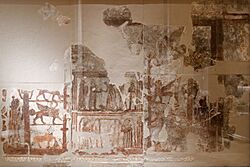Investiture of Zimri-Lim facts for kids
Quick facts for kids The Investiture of Zimri-Lim |
|
|---|---|

Overview of the fresco
|
|
| Material | Mural painting on white plaster |
| Size | 4.25 square metres (45.7 sq ft) |
| Height | 1.7 metres (5 ft 7 in) |
| Width | 2.5 metres (8 ft 2 in) |
| Created | c. 18th century BC |
| Period/culture | Amorite |
| Discovered | 1935–1936 |
| Place | Royal palace of Mari, Syria |
| Present location | Musée du Louvre, Paris |
| Identification | AO 19826 |
The Investiture of Zimri-Lim is a huge, colorful wall painting found in the Royal Palace of an ancient city called Mari. Mari was located in what is now eastern Syria. This special painting, called a fresco, was made around 1800 BC.
It shows Zimri-Lim, who was the king of Mari, getting important symbols of power from the goddess Ishtar. These symbols are a ring and a staff, which show he is the rightful ruler. The painting was found exactly where it was first painted, on a wall near the throne room of the palace. A French archaeologist named André Parrot discovered it in 1935–1936. Today, you can see this amazing artwork at the Musée du Louvre in Paris, France.
Contents
What Does the Painting Show?
This painting is made up of three parts, arranged in a balanced way. The two outer parts frame the middle section. The middle part is split into two horizontal areas, separated by colorful lines. Because the painting is symmetrical (meaning it's the same on both sides), experts could figure out what the damaged left side originally looked like.
The painting actually shows parts of the palace where it was found! For example, the bottom part of the middle section looks like the room where a statue of a goddess was discovered. This statue was similar to the goddess Lama shown in the painting. That statue even had a vase that flowed with real water! This room led to the throne room, which is where the main scene of the painting takes place. The palm trees on the sides of the painting represent real trees that grew in the palace's courtyard.
The Main Scene: A King Receives Power
The top part of the middle section is the most important. It shows the serious moment of the investiture, which means giving someone official power. There are five people standing in this scene. The goddess Ishtar wears a special crown, and weapons seem to grow from her shoulders. She holds a sword in one hand and gives the king the rod-and-ring symbol with the other.
King Zimri-Lim reaches out his left hand to the goddess. His right hand is near his mouth, which was a way to show respect or prayer. On each side of the king and Ishtar stands a Lama deity. These were minor goddesses in Mesopotamia who helped people talk to the main gods. They wear special horned hats. To the right of Ishtar is Ninshubur, who was like Ishtar's helper.
Symbols of Good Fortune
The bottom part of the middle section is also balanced. It shows good luck and wealth for King Zimri-Lim's rule. Here, the goddess Lama pours water from a round vase. Plants grow from the vase, and fish swim in the flowing water. This shows that the land will be fertile and prosperous under the king's rule.
The Palace Garden and Mythical Creatures
The outer parts of the painting show a garden with palm trees and another strange tree with a red trunk and blue leaves. A Lama deity stands in this garden on each side of the main scene, raising her hands in prayer. You can also see three mythical animals: a lion, a sphinx (a creature with a human head and a lion's body), and a bull with a human head. These animals are placed evenly on both sides and face the central scene. Flying doves, which represent the peaceful side of Ishtar, balance out the lion, which shows her fierce side.
The symbols and pictures in this painting are often compared to the figures on top of the famous Stele of Hammurabi.
Bringing the Painting Back to Life
This amazing wall painting was not in good shape when it was found. This was because of the weather in the region and also because the palace was burned down. This happened when Hammurabi attacked and destroyed the city around 1760 BC.
The painting has been repaired and repainted many times over the years. Recently, experts at the Louvre museum cleaned it very carefully. This cleaning showed new details that had been hidden before, like the fish swimming in the water. It also made the colors of the painting bright and clear again!
Gallery
-
The winged lion symbolizes Ishtar's aggression.
See also
- Art of Mesopotamia
- Statue of Ebih-Il
- Statue of Iddi-Ilum





